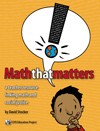Canadian Centre for Policy Alternatives, 2007
304 pages, $24.95
ISBN: 0-88627-512-1

Review by Brian Harrison
The experience is most likely a universal one for those of us who step into classrooms and teach every day: students, young and old, asking, "Why do we have to learn this stuff?" If the teacher is leading a Grade 7 or 8 math class, this question may be heard on a daily basis. This is, in part, due to the nature of the adolescent learner to question. But it is also because the dark secret of teaching resources and textbooks is to keep math safe, and therefore marketable. It is not my intention to diminish the contributions that educators and colleagues have made to the body of resources available for classroom instruction. However, it is clear that for those educators who wish to connect the real world with the study of math, while engaging the adolescents' hearts and minds in the pursuit of what is fair and just, there is a scarcity of content.
Fortunately, Toronto-based educator David Stocker has developed a compilation of math lessons that allows late junior and intermediate teachers a chance to deliver mathematics investigations that reflect both a commitment to diversity and social justice, and to what constitutes best practice in mathematics teaching. His book Math That Matters is part of the Canadian Centre for Policy Alternative's Education Project, which was established in response to growing concerns over the increasing role and influence of corporations within the domain of public education.
Stocker writes with a clear voice and from the perspective of a classroom teacher. While he is clearly committed to sound practice, he repudiates what he refers to as the "pizza party math" nature of current teaching resources, where, for instance, youth are asked to figure out "the volume of the pizza box, how many slices each should get and how much it will all cost." As he says in his introduction, we must distinguish between using things in the world around us (like pizza boxes) to "do math" and use math, instead, "to understand the world around us."
Challenging topics such as homophobia, class and poverty issues, child abuse and racial profiling form the context for the investigations, along with topics that relate to the exploitation of the environment, and workers' rights. Each lesson offers background information to help teachers introduce the lesson in a manner that reflects the sensitive nature of the topics, and in a developmentally appropriate way. Admittedly, many teachers will find the range and content of the topics to be beyond their comfort zone for teaching. Stocker, in the introduction, acknowledges this and invites the teacher to "spark discussion" and "to engage students in the democratic process and increase their interest in social justice advocacy."
The long tradition of the mathematician as an agent of change in society has been diminished in our current culture of teaching, as has the essence and discipline of mathematical inquiry: posing, reasoning and developing proofs in order to solve problems and explain the world in which we live. Too often our students are exposed to mathematics instruction that is based upon memorization of procedures, or what American education critic Alfie Kohn calls, "the bunch-o-facts" model of education. The true value of the lessons developed by Stocker lies in the engaging contexts, as well as the emphasis placed upon developing the student's critical thinking abilities. They are rich tasks about rich topics.
Math That Matters is a helpful resource for those of us who wish to honour our commitment to the guiding principles of our public education system while we provide effective, research-based mathematics instruction. In my classroom, 25 lively, gregarious and diverse Grade 7 and 8 learners spill into the room every day, many of them coming from challenging home situations. The great assets my learners bring - their willingness to challenge and question, their preferences for working in groups and talking through the problems they face, and their comfort with technology - are all emphasized in Math That Matters.
American educator and researcher Cathy Fosnot worked with inner-city students in New York City and her experience and subsequent writing has greatly informed the professional training focus that Ontario's Ministry of Education has developed for teachers. In her work, Fosnot stresses the role of context, challenging us not to teach math as if it were a "dead language" but to get our students to "mathematize their world." Taking these ideas into the classroom, I look to engage my students in tasks that will see them care enough to actually do the math and learn the habits of the mathematician through this process.
On this particular day, groups of my students are working their way through one of Stocker's investigations, called "Oink! Oink!" The focus of the investigation is on the disparity that exists between the wealth and resource use of industrially developed countries and that of poorer countries. My students make connections to their own consumption patterns and see the great differences in the rate at which Western nations use common resources. Underlying this investigation is the big mathematical idea of proportional reasoning: my students wrestle with the language and the mathematical models they will need to use to explain just how much more we use, and discuss the relative fairness of this reality.
"Hey, Mr. H! I can see why they called this one Oink! Oink!'" one of my Grade 7 students exclaims as he and his partners use spreadsheet programs to represent a comparison on a ratio table. Later, as they create coordinate graphs and extend these into algebraic expressions, they begin to develop a deeper understanding of how the elegance of mathematics can be used to reason and persuade. They begin to develop the language to express what they now know is a fundamental pattern of global inequity.
At its core, mathematics is a common language that we can all use to express patterns and relationships that are grounded in the real world a world where rights are often violated and those with power and influence often attempt to deflect or distract us from the most important issues and concerns. No pizza boxes here.
Some believe that the route to reaching and teaching older children who struggle with mathematics is drill and repetition, and the accumulation of basic facts, through intensive tutoring programs. Rather than kill with drill, however, I'll cast my lot with the vivid, socially aware and mathematically challenging problems that Stocker has offered up to us. Math That Matters is, indeed, math that matters. It matters to the engagement of our students, it matters to the development of young leaders in our communities, and it matters to teachers who wish to reconnect with the reasons they chose the profession in the first place.










